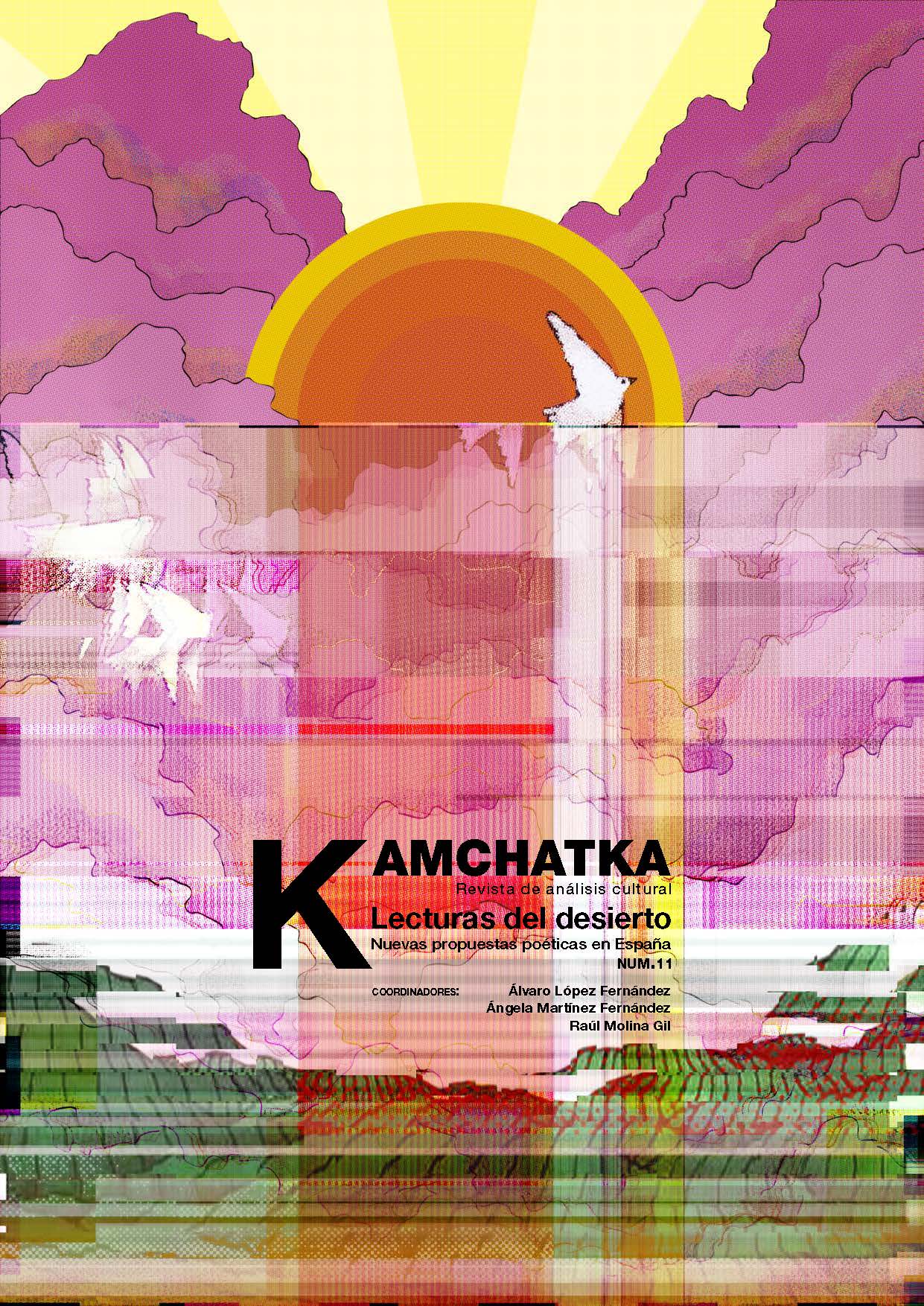Maps for these territories don’t exist: Rubén Martín (Díaz) and the aesthetic topography of recent Spanish Poetry
DOI:
https://doi.org/10.7203/KAM.11.11325Keywords:
ekphrasis, language, nature, poetic form(s), reality. Abstract
Abstract
Building from the premise that the world of contemporary Spanish poetry is not a neutral discursive space open to all textual approaches, this study will trace the aesthetic strategies employed by two contemporary Spanish poets whose similar names—Rubén Martín Díaz (1980) and Rubén Martín (1980)—require us to look beyond the authors’ signatures and immerse ourselves in the textual approaches that characterize their poetic projects. Although the work of each poet establishes a compelling dialogue with many of the same concepts—the gaze, the natural world, the I, and language—its way of conceiving of these concepts and their complex interaction differs. In the case of each poet we will study ekphrastic texts alongside other texts, which, together, offer a vision of each textual approach’s attitude towards the fragmented world in which we live. This exploration will provide us with a clearer picture of the aesthetics of Contemporary Spanish Poetry and its relationship with past Spanish literary traditions. Although this study only focuses on the work of these two poets it also seeks to situate their work in the larger context of current Spanish poetry.
 Downloads
Downloads
 References
References
“Defensa de la poesía”. (2011). Poesía ante la incertidumbre. Antología (Nuevos poetas en español). Madrid: Visor: 7-12.
Dickinson, Emily (2010). Poemas a la muerte. Trad. Rubén Martín. Velilla de San Antonio (Madrid): Bartleby Editores.
Floriano, Miguel y Rivero Machina, Antonio (2016). “Epílogo”. Floriano, Miguel y Rivero Machina, Antonio (eds.). Nacer en otro tiempo. Antología de la joven poesía española. Sevilla: Renacimiento: 223-228.
García, Manuel. “Entrevista al poeta Rubén Martín tras publicar su poemario ‘Sistemas inestables’” lecturaobligada (2016).
García Cerdán, Andrés. “El mirlo blanco: Rubén Martín Díaz”. ABC Toledo 21-4-2016.
Graham, Jorie (2014). Rompiente. Trad. Rubén Martín. Velilla de San Antonio (Madrid): Bartleby Editores.
Lanz, Juan José (2012). “Dibujo de la muerte: écfrasis e imitación artística en la poesía de Guillermo Carnero”. Díaz de Castro, Francisco y del Olmo Iturriarte, Almudena (eds.). Écfrasis e imitación artística en la poesía hispánica contemporánea: Diez propuestas. Sevilla: Renacimiento: 111-36.
Mammos, Rafa. “‘Sistemas inestables’, de Rubén Martín”. Quimera. Revista de literatura 388 (2016): 64.
Martín, Rubén (2007). Radiografía del temblor. Sevilla: Renacimiento.
Martín, Rubén (2010). El minuto interior. Madrid: Ediciones Rialp.
Martín, Rubén (2015). Sistemas inestables. Velilla de San Antonio (Madrid): Bartleby Editores.
Martín, Rubén, Callejón, Begoña y Panero, Leopoldo María (2010). Locos de altar. Granada: Editorial Alea Blanca.
Martín Díaz, Rubén (2012). El mirador de piedra. Madrid: Visor.
Martín Díaz, Rubén (2015). Arquitectura o sueño. Sevilla: Ediciones de La Isla de Siltolá.
Martín Díaz, Rubén (2016). Fracturas. Albacete: Nausícaä.
Mitchell, W. J. T. (2009). Teoría de la imagen: Ensayos sobre representación verbal y visual. Trad. Yaiza Hernández Velázquez. Madrid: Akal.
Morán Rodríguez, Carmen (2012). “Escribir con ceniza dibujos de ceniza: Ashes to ashes, de Ada Salas y Jesús Palencia”. Díaz de Castro, Francisco y del Olmo Iturriarte, Almudena (eds.). Écfrasis e imitación artística en la poesía hispánica contemporánea: Diez propuestas. Sevilla: Renacimiento: 159-82.
Morante, José Luis (2016). “Prólogo”. Morante, José Luis (ed.). Re-generación. Antología de poesía española (2000-2015). Granada: Valparaíso Ediciones: 11-41.
Persin, Margaret H. (1997). Getting the Picture: The Ekphrastic Principle in Twentieth-Century Spanish Poetry. Lewisburg: Bucknell University Press.
Talens, Jenaro (1989). De la publicidad como fuente historiográfica. La generación poética española de 1970. Valencia: Episteme.
Downloads
Published
How to Cite
-
Abstract1638
-
Artículo (Español)625
Issue
Section
License
This journal provides an immediate free access to the content on the principle that freely make investigation available to the public, which promotes an increased global knowledge exchange.
Unless otherwise indicated, texts published in this journal are under the license Attribution-NonComercial 4.0 by Creative Commons. These texts may be copied, distributed and publicly communicated whenever the publication’s author and title are quoted and whenever they are not used for commercial purposes. In any case, intellectual property of the articles and its potential economic rights entirely belong to its authors.
The full license can be consulted on https://creativecommons.org/licenses/by-nc/4.0/. We encourage authors to disseminate papers published in Kamchatka. Journal of cultural analysis electronically, in institutional digital repository or in their websites.





